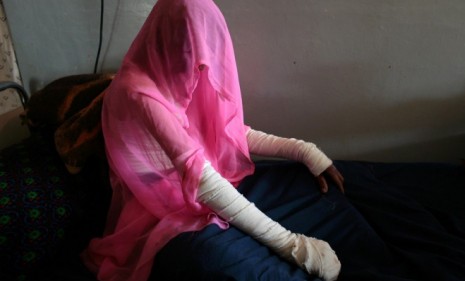Self-immolation: A brief history
A Tunisian man who set himself on fire inspired an uprising that toppled his country's government. But he wasn't the first, or the last, to do it

Market vendor Mohammed Bouazizi, 26, triggered an uprising in Tunisia last month when he set himself on fire in front of his town's municipal building. Bouazizi was distraught after police confiscated his fruit and vegetable cart, and his goal, apparently, was to protest months of harassment by authorities. (Watch an al Jazeera report about Bouazizi's suicide.) But — as other self-immolations have in the past — Bouazizi's act shocked and moved his countrymen, and the revolt that followed toppled the Arab country's iron-fisted leader, President Zine El Abidine Ben Ali. Here, a brief history of this gruesome but powerful form of protest:
527
Daodu, a Buddhist monk, climbs a mountain and sits down, surrounding himself with wood. He lights the kindling, puts his hands together, and recites verses as he is engulfed in flames, according to Burning for the Buddha: Self-Immolation in Chinese Buddhism, a book by James Benn, a religion professor at Canada's McMaster University. But the tradition of self-immolation in Chinese Buddhism, which dates to the fourth century, was seen as an expression of faith, not political protest.
The Week
Escape your echo chamber. Get the facts behind the news, plus analysis from multiple perspectives.

Sign up for The Week's Free Newsletters
From our morning news briefing to a weekly Good News Newsletter, get the best of The Week delivered directly to your inbox.
From our morning news briefing to a weekly Good News Newsletter, get the best of The Week delivered directly to your inbox.
1829
India outlaws the practice of sati, in which a widow burns herself on her husband's funeral pyre, although it is still done in some communities. The tradition has been linked to the myth of Sati, a wife of the Hindu god Shiva, who burned herself to death after her father, who disapproved of her marriage, insulted her husband.
1963
Thich Quang Duc, a Vietnamese Buddhist monk, sits down in a busy Saigon intersection, douses himself with gasoline, and sets himself on fire to protest persecution of Buddhists in South Vietnam under the rule of Ngo Dinh Diem. Photojournalist Malcolm Brown is there and snaps a photograph that wins a Pulitzer Prize and becomes one of the iconic images of the Vietnam War era. Four more monks and a nun also burn themselves to death before Diem's regime falls later that year.
A free daily email with the biggest news stories of the day – and the best features from TheWeek.com
1967
A 56-year-old California woman, Florence Beaumont, burns herself to death on the steps of the Federal Building in Los Angeles, motivated by what her husband, George, calls "a deep feeling against the slaughter in Vietnam." Before killing herself, Beaumont, a mother of 18- and 20-year-old daughters, had written her elected representatives to express her views, and complained that she only received form letters in return. Several others set themselves on fire to protest the war, including an 82-year-old woman in Detroit and a 31-year-old Quaker, Norman Morrison, who, clinging to his own child, ignited himself under the Pentagon window of Defense Secretary Robert McNamara's office. Morrison died; the child survived.
1969
Jan Palach, a 20-year-old student, sets himself on fire in Prague to protest his countrymen's apathy five months after the Soviet occupation of Czechoslovakia.
1994
Homa Darabi, a 54-year-old woman, kills herself the same way in Iran, protesting the erosion of women's rights under the Islamic Revolution.
March 2009
Afghanistan's Ministry of Women's Affairs begins tallying cases in which women — powerless in their fundamentalist Muslim communities to protest beatings, rape, and other abuses — set themselves on fire. Within a year, the ministry has recorded 103 such cases. More than 80 percent of women who try to kill themselves this way cannot be saved, says Dr. Ahmed Shah Wazir, head of the burn unit at Kabul's Istiqlal Hospital, one of two such specialized wards in Afghanistan.
Dec. 17, 2010
Tunisia's Mohammed Bouazizi, after being slapped and insulted by officials who confiscated his fruit cart, stands outside his town's municipal offices, pours a liter and a half of gasoline over his head, and sets himself ablaze. He is taken to a hospital, and, wrapped head to toe in bandages, clings to life as violent protests erupt across Tunisia.
Jan. 5, 2011
After struggling near death for two weeks, Bouazizi succumbs to his burns. His grieving relatives, friends, and admirers proclaim him a martyr, and anti-government protests intensify.
Jan. 14, 2011
President Zine El Abidine Ben Ali, who had ruled Tunisia "with an iron fist" since 1987, flees to Saudi Arabia. Bouazizi's self-immolation is universally seen as the act that uncorked years of pent up resentment about the government's abuses and started the uprising.
Jan. 21, 2011
Three Egyptian men set themselves on fire to protest their government. Theirs are the latest in a series of self-immolations, apparently inspired by Bouazizi's martyrdom, in other Arab countries, including Egypt and Algeria.
Sources: Time (2), CNN, Wash. Post, Al Jazeera, Reuters, Spokane Daily Chronicle
-
 Why is pizza in decline?
Why is pizza in decline?In the Spotlight The humble pie is getting humbler
-
 A modern ‘Lord of the Flies,’ a zombie sequel and Jodie Foster’s first French-speaking lead role in January movies
A modern ‘Lord of the Flies,’ a zombie sequel and Jodie Foster’s first French-speaking lead role in January moviesthe week recommends This month’s new releases include ‘The Plague,’ ‘28 Years Later: The Bone Temple’ and ‘A Private Life’
-
 Iran cuts internet as protests escalate
Iran cuts internet as protests escalateSpeed Reada Government buildings across the country have been set on fire